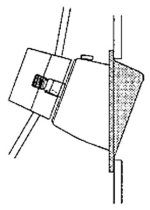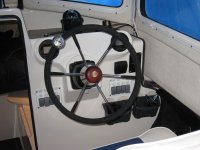Oh boy! I'm not sure I want to wade into all this but if I had any common sense I wouldn't be in the boat business to start with!
Okay, to start with same basic information:
The SeaStar system will run just under $1,000 (street price) if you buy the kit (helm pump, steering cylinder, steering fluid) and the hoses (not included in the kit).
The BayStar systems will run just over $500 (street price) if you buy the kit, which is everything needed to install the system (including tools and a video).
So really, the SeaStar system is just a bit under twice as much as the BayStar. Don't jump to conclusions here though, there's still only about $450 (or thereabouts) difference in the systems and typically I wouldn't consider that a make-or-break decision for the boats most of us are concerned with.
There are quite a few other considerations:
The BayStar uses 5/16" hard nylon tubing for steering lines, the tubing can be cut as needed and compression fittings are used for connections. This makes precise lengths and adding things (like an autopilot) pretty easy. The small lines are also a bit easier to route in small spaces.
The SeaStar uses 3/8" high-pressure hoses with swaged ends. The hoses must be ordered to length to fit the application and changes to the system later require either new hoses or new swaged ends (usually done by a specialist shop). Typically one is restricted to ordering stock lengths of Teleflex hose and they're relatively expensive (~$140 for the pair used on a CD22). Since they're a fixed length they're not quite as easy to fit since you have to deal with any extra length that's not needed.
For instance, if you add an autopilot or second station to a boat with SeaStar then you usually have to pull (and not use) the steering hoses already in the boat. Then you need to order new hoses, and each set is expensive (the 2-footers are still over $100/set). The SeaStar fittings are also more expensive than the BayStar compression fittings.
The bottom line is that by the time a full steering system is installed with an autopilot the SeaStar ends up costing quite a bit more with all the added components.
Over the years the BayStar system has seen a complete redesign, it's a completely different system than it was when introduced. Now the BayStar is really just a smaller SeaStar system sharing the same basic design of the helm pump and steering cylinders.
My viewpoint is that the BayStar is, say, a small pickup (like a Toyota Tacoma); the SeaStar is a full size pickup (like a Tundra). If you choose to drive a Tacoma because is does what you need it to that doesn't mean that you've compromised and purchased a lesser truck just because you could have bought a full sized truck. I don't think Tacoma drivers feel inferior to Tundra drivers!
Since the design of the two systems is so similar now what Teleflex is really doing is just offering two "sizes" to fit a myriad of applications. From a marketing standpoint they're going to sell a lot more $500 BayStar systems to small boat owners (typically under 20-feet) than they are $1,000 SeaStar systems (if that's all they offered) so it makes sense to have two systems.
The BayStar system is intended to be a simple single-station system that's a DIY solution for small boats; it even comes packaged just for that market. Teleflex does not officially endorse adding an autopilot and/or a second station to a BayStar system. When I checked with their engineers about this years ago they told me that it's not an engineering limitation and that it would work fine (and it does); rather they (Teleflex) had made the decision not to write manuals on how to do twins, or autopilots, or second stations, and they weren't going to produce any tie-bars or hardware (for the BayStar) to accommodate those situations. They told me they had no reservations in us adding what we wanted to but that we were going to have to figure how to do it and what components were necessary.
The Sea Star system is intended for professional installation (for the most part) and there are a wide range of special fittings and components to accommodate almost any boat (it's also used on inboard boats).
We replaced seals on both the BayStar and SeaStar systems and haven't noticed a lot of difference in which system needed the seals. That excepts the early BayStar systems (composite helms and early cylinders) that did need seals replaced all too often (hence a lot of the ensuing changes).
Personally, I think the choice merits thought but not a lot of anguish. If you use a BayStar system in the correct application (150hp and below, and not a performance boat) it does a fine job. That said, if one is more comfortable with the bigger-is-better viewpoint then the extra cost of the SeaStar system is a small price to pay for peace-of-mind. There are plenty of applications where the SeaStar system is *the* choice, but CD22's, Marinaut's, and the like aren't one of them unless there are some specific requirements or you just absolutely want it for personal reasons.
I might also add that I don't agree with an earlier observation I saw regarding loss of steering with the failure of a hydraulic steering system. It is true if you loose the hydraulic steering system that it no longer controls the engine. That said, it leaves the engine in a condition (loose) where it can be turned by other methods (hand, boat hook lashed to it, etc). By comparison, I've dealt with many mechanical systems that failed and left the engine locked in one position until the mechanical system could be removed (or fixed). The loss of steering is very situational and any particular instance could leave you wishing for one system or the other...depending.
Hope all this verbiage helps!



